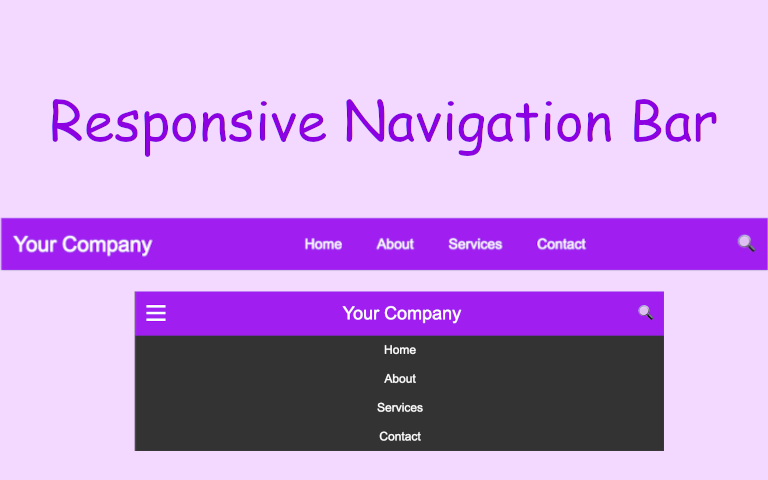Create a Responsive Navigation Bar using HTML, CSS, and JavaScript
Posted by Kosal

Creating a beautiful menu bar using HTML, CSS, and JavaScript involves creating the structure with HTML, styling it with CSS, and adding interactivity with JavaScript. Here's a simple example of a responsive and stylish menu bar:
HTML:
<!DOCTYPE html>
<html lang="en">
<head>
<meta charset="UTF-8" />
<meta name="viewport" content="width=device-width, initial-scale=1.0" />
<link rel="stylesheet" href="styles.css" />
<title>Responsive Menu Bar</title>
</head>
<body>
<div class="navbar">
<div class="toggle-btn" onclick="toggleMenu()">
<span></span>
<span></span>
<span></span>
</div>
<div class="logo">Your Company</div>
<div class="menu">
<a href="#">Home</a>
<a href="#">About</a>
<a href="#">Services</a>
<a href="#">Contact</a>
</div>
<div id="searchBar">
<input type="text" id="searchInput" placeholder="Search..." />
</div>
<div class="search-btn" onclick="toggleSearch()">
<span>🔍</span>
</div>
</div>
<div class="content">
<!-- Your page content goes here -->
<h1>Welcome to Your Company</h1>
<p>This is a professional menu bar example.</p>
</div>
<script src="script.js"></script>
</body>
</html>
CSS (styles.css):
body {
margin: 0;
font-family: "Arial", sans-serif;
background-color: #f4f4f4;
}
.navbar {
background-color: #a020f0;
padding: 0 15px;
display: flex;
justify-content: space-between;
align-items: center;
box-shadow: 0px 2px 5px rgba(0, 0, 0, 0.1);
height: 60px;
}
.logo {
color: white;
font-size: 24px;
}
.menu {
display: flex;
justify-content: center;
align-items: center;
}
.menu a {
color: #fff;
text-decoration: none;
margin: 0 20px;
font-size: 16px;
transition: color 0.3s;
}
.menu a:hover {
color: #ffcc00;
}
.search-btn span {
color: #ddd;
border: none;
cursor: pointer;
font-size: 20px;
}
#searchBar {
display: none;
}
.show {
display: block !important;
}
.hide {
display: none !important;
}
#searchInput {
opacity: 0;
width: 0;
padding: 0;
transition: opacity 0.3s, width 0.3s;
}
.show #searchInput {
opacity: 1;
width: 150px;
padding: 8px;
}
.toggle-btn {
display: none;
flex-direction: column;
cursor: pointer;
}
.toggle-btn span {
height: 3px;
width: 25px;
background-color: white;
margin: 6px 0;
display: block;
}
.show-menu {
display: flex !important;
}
@media screen and (max-width: 768px) {
.menu {
display: none;
flex-direction: column;
width: 100%;
text-align: center;
position: absolute;
top: 60px;
left: 0;
background-color: #333;
box-shadow: 0px 2px 5px rgba(0, 0, 0, 0.1);
}
.menu a {
margin: 10px 0;
}
.toggle-btn {
display: flex;
}
}
JavaScript (script.js):
function toggleSearch() {
const searchInput = document.getElementById("searchBar");
searchInput.classList.toggle("show");
const menu = document.querySelector(".menu");
menu.classList.toggle("hide");
}
function toggleMenu() {
const menu = document.querySelector(".menu");
menu.classList.toggle("show-menu");
}
This example includes a responsive menu bar with a toggle button for smaller screens. The menu bar has a simple color scheme, and you can further customize the styles to fit your design preferences. The JavaScript function toggleMenu is used to show/hide the menu on smaller screens.